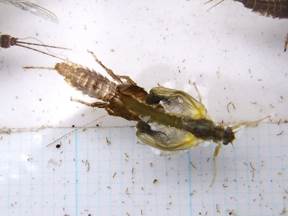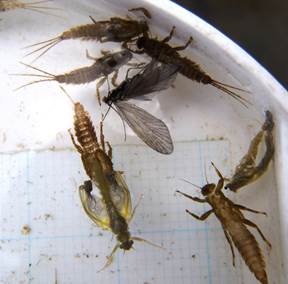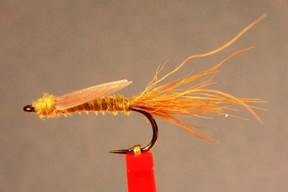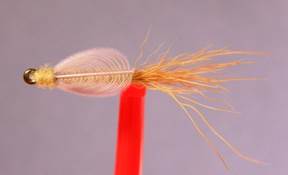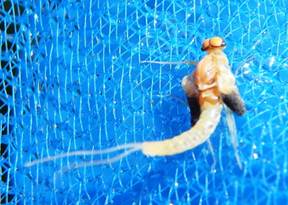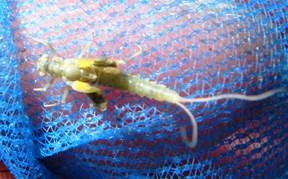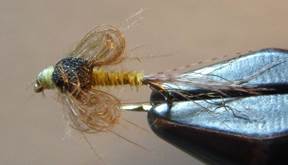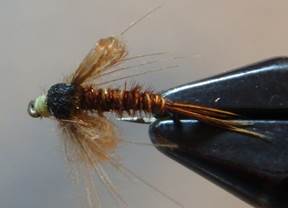FLY DESIGNING - YEARLY CYCLE
Mostly, because I was raised in a farming family, I like the seasonal or yearly cycle in my life. There are: preparation periods, busy time, long days, short days, transitional period, slow days, and harsh times (such as Montana winter!). Luckily I'm seasonally involved in agriculture, then I guide through summer (well, my outfitting operation is open year around), and tie and sell flies as a commercial tyer through winter to spring. For me, that's my version of Montana life.
Over the past several years, as a guide and a fly-dresser, I have noticed another "flow" in my own yearly cycle. Through my fishing and guiding I observe a lot and take a lot of "mental notes". Then I write in my journal at each night; trout behavior, what trout were feeding on, what insects were hatching and on the surface, and what I found with stomach-pumps. Each moment and incident can be a snapshot and some may stay in my memory. However, when all categories come together it does stick deeply in my brain. I think about that particular experience through the season, just to figure out if it's possible to come up with better methods or fly patterns.
Methods and techniques can vary : fishing on my own, guiding clients, clients' skills, water type, seasons, weather conditions, sections of streams, and so many things. It all comes with experience and the best habit I can keep up is to store as much as I can in my "brain drawers". Then in order to keep our brain-drawers stuffed and updated, keep journals!! Regardless of our age, health, and other factors, we all have to admit that our memorizing ability does have limitations. We simply can't keep remembering – especially if one goes fly-fishing half of the year and observes so many different things.
Same goes with my fly developing process and cycle. Luckily I'm in one of the most popular and busiest fly-fishing destinations in the nation. With several renowned shops, reputed outfitters/guides, die-hard local anglers, and visiting anglers from all over the nation and world talking about fly-fishing, so many fly patterns are also passing through the area (plagiarism is not a part of this article!). Top of that, I'm blessed to fish and guide Livingston's spring creeks, where so many different species of insects coexist and trout selectively feed on what available to them or one particular stage of insect hatches. Observing trout behavior and our fly selections are the first components and our catching results would tell us if we did it right or wrong. Then these will be recorded to my journal, along with effective fly patterns. However along the process, I can't emphasize how important surface seining and stomach-pumping are. Indeed these two actions validate my fly selections and methods of executions. I, of course, write down what I find and observed in my journal. Every so often I come across particular stages and forms of insects that vividly remain in my retina and memory. I then wonder if there are fly patterns that can imitate this stage – most likely not among existing patterns and that's why they strike me – and if I can come up with some particular patterns. At the same time I know new patterns –require some creative thoughts and techniques – and they don't come easy or quick. I write down brief images and concepts in my journal or on the separate sheet that I leave on my tying bench, both of which keep clicking and twitching my brain gently, as well as a kind reminder, so I may develop something or work on them when I have time.
It usually goes like this. Pale Morning Dun hatch on Livingston's spring creeks is oh-so-prolific and phenomenal. I just can't emphasize how lucky I'm to be there as a guide (and occasional fisher myself). We simply see so many insects hatching and then so many trout filling up the creek and acting accordingly – greedily feeding on nymphs in the water column and happily rising to the surface. As much as I'm happy to see all the great action and anglers' huge smiles, it's a great time for me to observe which stages of this iconic mayfly are present and eaten. If one particular stage is eaten more than the other, I try to think of the possibility of new patterns that are different from existing patterns. Then there are some eye-opening discoveries once in a while (more below). Either way, those memories and notes will stick with me and keep ticking through summer; from July and after I'm busy with guiding anywhere beside spring creeks. Certainly I don't have time to sit and ponder at my tying bench. Yet I keep thinking of ideas and potential new patterns every now and then.
Then I start to have open days in September and October. I sit and gather my thoughts at my bench. I come up with some trial versions. For next year?, no, another iconic mayfly = the Baetis mayfly hatch is right around the corner. That will be a great time to experiment and hope to validate my new patterns. We also have a Baetis hatch in spring too. If my new patterns keep being approved by trout I will be very confident to present the PMD versions to my clients and trout.
Another direction is also true. The fall Baetis hatch on Livingston's spring creeks is also iconic yet much more challenging than PMD or spring Baetis. The water gets lower and by then the trout have seen all kinds of flies and presentations. On top of that, trout don't feed actively any more. They feed instinctively only when the hatch is strong and insects floating toward them. So we have to match precisely what they are feeding with the best presentation we can summon! This is another great time to observe, ponder, and come up with new patterns – ideally to experiment and to get results if I can. If I can go through, it'll be great. Fall experiments and experience are very significant and give me lots of confidence for the future. Then I can expect the spring Baetis hatch. I can experiment more and perhaps improve some. After all of these observations and notes, by changing sizes and colors, I'm ready to present my PMD versions with confidence.
Midge patterns nearly follow the same cycle. Midges will hatch all through the season on spring creeks. I again have more time to fish and develop patterns in fall and spring. Then summer midge fishing is another most challenging fishing on spring creeks. They tend to be smaller than fall and spring. Yet trout selectively gorge on them over other larger food sources – mayflies, caddis, and terrestrials. I would guess it's due to abundancy. Anyways, working on midge patterns in fall and spring and then stocking them up will pay off for summer hatches.
I have plenty of time to design and experiment my potential new nymph patterns. From fall to early spring, nymph fishing is the mainstay when one dares to go fishing and try to be productive. There are some good waters that are open through the year around here: the Yellowstone, Madison, Gallatin, and spring creeks. When situations call for nymphing during our main fishing season, those already validated nymph patterns through slower season will be cast out with great confident and will catch trout.
So this is my fly designing yearly cycle, which I love to incorporate to in my entire life cycle. Now let me share two of my patterns that were born and then validated through this cycle.
VS Emerger
VS = Very Surface Emerger was inspired by one of many stomach-pumping results during PMD hatch. Even when trout rose to our dry-flies (dun and emerger imitations), I just can't emphasize the numbers of nymphs eaten and pumped out (top right picture). Then I found several individuals that were just coming out of their nymph shucks with folded wings. I hadn't seen any patterns that would imitate this stage or silhouette. I was pondering through summer. Then finally sometime in October of that year, I started to play some at my bench and came up with a prototype. I tested on fall Baetis hatch. Trout responded! I tweaked some during winter. Then it worked during spring Baetis hatches in the following year. Not to mention, it was taken by trout without any doubts during PMD hatches next year.
|
|
|
|
- Hook: Dai-Riki 310 #16-20
- Thread: Veevus 16/0
- Tail (nymph shuck): Snowshoe Rabbit feet hair
- Abdomen: Turkey biot,
- Thorax & Head: Superfine Dub
- Wing: Hen hackle, long enough fibers gathered and looped.
*Find and use appropriate colors for thread, shuck, abdomen, and dubbing to match species you want to imitate.
**I can't adapt to Drake species, size 14 or larger, because I can't find long enough wing materials to achieve the same silhouette.
Buddy Wing Nymph & Emerger
The Buddy Wing Nymph & Emerger follow the similar story. Again, during PMD hatches I was seining the surface. I collected and observed very unique stages or forms of some individuals. They were totally hatched-out duns; however their wings somehow were not fully developed or perhaps damaged (top two pictures). Another condition was the dun (or emerger) that was struggling to escape its nymph shuck on the surface. Wings were in the same form and silhouette as the former examples (but sorry no picture on this one). They were hopelessly floating on the surface until drowned or eaten. How could I simulate this? In October of the same year, I came up with a prototype that looked satisfyingly expressing my intention. I was up for Fall Baetis hatch at DePuy's Spring Creek. Trout approved immediately! I gave away a few samples to my neighborhood fishermen. They reported good results.
|
|
|
|
Choosing wing materials, how to manipulate them, and how to add floatation on the entire fly required some creativity. I came up with as such. For the names' sake, originally I developed an emerger with pheasant tail fibers – this was the original "emerger". However, I started to experiment with different tail and abdomen materials which add more color. I liked them and also the new version was as great as the original. Adding colors of duns (bottom left picture), I now started to call this "Emerger", and hence the original was christened as "Nymph" (bottom right). Either way, both are dry-flies that float really well and are very visible due to three-dimensional wings.
B.W. NYMPH
- Hook: Dai-Riki 125 or 320 #12-22
- Thread: Veevus 16/0
- Tail & Abdomen: Pheasant tail
- Thorax: Superfine Dub and a black foam strip over
- Wing: natural dun CDC
B.W. EMERGER
- Tail: several synthetic fibers and several mallard flank fibers on top
- Abdomen: turkey biot.
Rest of materials is same as B.W. Nymph.
*Both straight and curved hook work equally.
**Both can be adapted to imitate from Drake (size 12) to Baetis (size 22). Match sizes and colors of materials for species that you want to imitate.
My cycle goes on. Let's see what I come up with next……….
Satoshi Yamamoto, www.leftyanglerandflies.com, is a Livingston, MT based outfitter and a fly dresser.

